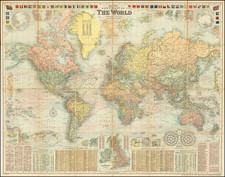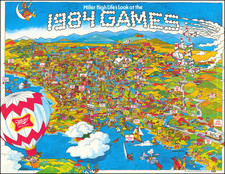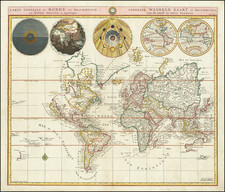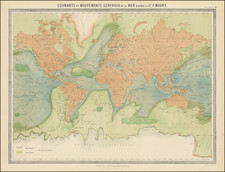Rare Reduce Sized Variant
A decorative Air France poster map by Lucien Boucher, based on his 1948 map. The map presents a lively pictorial view of the World, with Air France routes extending to Buenos Aires, the Eastern United States, Tehran, Calcutta, Shanghai, Manila, Saigon, Hong Kong, Hanoi, Madagascar, Mauritius, and East Africa.
The imagery used further adds to the attractiveness of the map. East Asia is represented with images of temples, tigers, and palaces. Wildlife and forests populate the wilder parts of the map. Planes can be seen to fly the various Air France routes, and ships of all make sail the oceans. Boucher's surrealist style is readily apparent in the present map.
Lucien Boucher was a famed French cartoonist of the mid-20th century. He trained at the ceramics school in Sevres and started his career as a cartoonist for a satirical magazine. Lucien Boucher then moved to launch a design career attuned to the commercial promise of surrealism. He was contracted by Air France started in 1935, and designed a number of travel posters for the company, working well into his seventies.
Boucher's work for Air France was key in revolutionizing the way in which airline advertisements occur. While previous work focused on advertising a single route, Boucher chose to portray Air France's extensive global empire in his advertisements. This contributed to a change in the way people thought about airlines and helped to create a branding image that we still recognize today for upper-tier airlines. For his work, Lucien Boucher became known as "Monsieur Planisphere" at Air France.
This is the small format version of the poster, printed with offset lithography.
Lucien Boucher (1889-1971) was a French artist whose work spanned various mediums including cartooning, painting, and illustration. Born in Chartres and educated at the École de Céramique de Sèvres, Boucher initially focused on ceramics before World War I significantly altered his artistic trajectory. His period of captivity as a prisoner of war during the conflict led him to discover and hone his skills in drawing, thereby shaping his future career.
Before the war, Boucher had already begun to make a name for himself in the French art scene, particularly through his cartoons published in the weekly magazine "Le Rire." His early works demonstrated his capability for visual satire, but his subsequent experience in the war led to a more serious engagement with themes and subjects. After his return, Boucher navigated toward commercial illustration and poster design, successfully integrating his artistic sensibilities with the needs of the market.
Starting in the 1920s, Boucher began to produce a series of posters that drew inspiration from the surrealism movement. This work culminated in his most well-known project: a series of planispheric and celestial maps designed for Air France. These maps served a dual purpose. While they were essentially utilitarian, providing navigational information, they were also aesthetically innovative. Boucher employed elements of surrealism to add layers of meaning, transforming what could have been straightforward maps into more complex visual narratives.
Boucher's work with Air France solidified his reputation as an artist who could balance commercial needs with artistic innovation. His approach to map-making was characterized by a careful attention to detail, a strong sense of composition, and a willingness to explore the boundaries of the medium. While his maps were intended to serve a practical function, they also succeeded in capturing the public's imagination, offering a vision of travel that was aspirational yet grounded in geographical realities.










![[World] Dated Events War Map . . .](https://storage.googleapis.com/raremaps/img/small/88833.jpg)
![Official Texas Brags Map of North America . . . Scale One Inch = 6 Texas Grapefruit [With Original Envelope!]](https://storage.googleapis.com/raremaps/img/small/70748.jpg)


